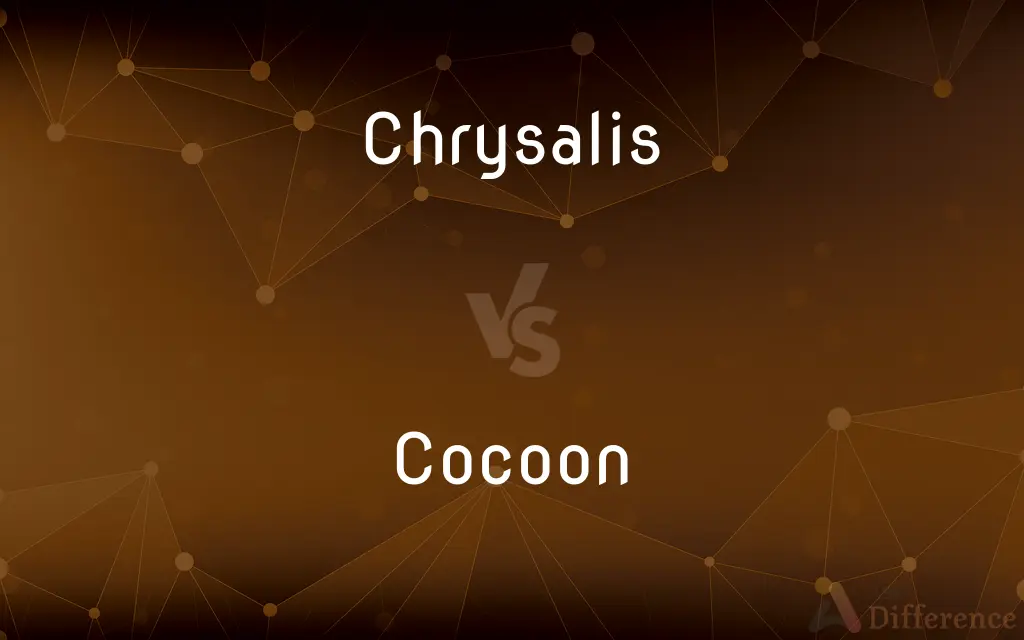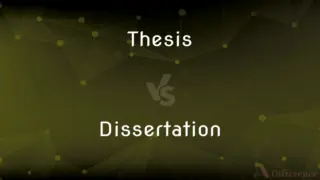Chrysalis vs. Cocoon — What's the Difference?
By Fiza Rafique & Urooj Arif — Updated on April 16, 2024
A chrysalis is a type of pupa in butterflies, having a hard protective covering, whereas a cocoon, made by many moths, surrounds the pupa with a silk covering.

Difference Between Chrysalis and Cocoon
Table of Contents
ADVERTISEMENT
Key Differences
A chrysalis is specific to butterflies and is the hardened outer protective layer formed from the outer skin of the caterpillar during the pupal stage. On the other hand, a cocoon is created by many moths and some other insects, which involves spinning a silk-like material to encase themselves during their pupal stage.
Chrysalises are generally exposed and attached to leaves or branches without additional coverings, relying on their hard, often camouflaged exterior for protection. Conversely, cocoons are typically enveloped in silk which can be buried in the ground, hidden in leaves, or suspended in the air, providing thermal insulation and physical protection from environmental threats.
The formation of a chrysalis involves the shedding of the caterpillar’s skin to reveal a pre-formed chrysalis underneath, which then hardens. In contrast, the creation of a cocoon involves the insect spinning silk from a special gland in its mouth to create the protective silk casing around itself.
In terms of biological function, both structures serve as a protective enclosure during the pupal stage, where the caterpillar transforms into its adult form. However, the chrysalis is typically more rigid and streamlined, aiding in a quicker and more visible transformation, while cocoons may also serve as a mechanism for surviving adverse weather conditions, particularly in colder climates.
Visually, chrysalises tend to be more varied in color and can be ornate, reflecting their often visible nature in the environment. Cocoons, on the other hand, are usually more uniform in appearance, often white or brown, and are less likely to be seen due to their hidden or buried locations.
ADVERTISEMENT
Comparison Chart
Associated With
Butterflies
Moths and some other insects
Composition
Hardened outer skin of the caterpillar
Silk-like material spun into a protective layer
Location
Exposed on leaves or branches
Often buried, hidden in leaves, or suspended
Formation
Shedding of skin to reveal a pre-formed chrysalis
Spinning of silk to create a casing
Function
Protects during transformation into butterfly
Insulates and protects during transformation
Compare with Definitions
Chrysalis
The pupal stage of butterflies, characterized by a hard protective case.
The butterfly emerged from its chrysalis transformed and ready to fly.
Cocoon
Serves both as a protection against predators and harsh environmental conditions.
The cocoon insulated the pupa during the cold winter months.
Chrysalis
Known for being often camouflaged or brightly colored as a form of protection.
The green chrysalis blended perfectly with the surrounding leaves.
Cocoon
The silk is produced from a gland in the insect’s mouth.
The caterpillar spun its cocoon using silk extruded from its mouth.
Chrysalis
A visually distinctive stage in butterfly development.
We watched the chrysalis hanging silently on the branch, knowing a butterfly would soon appear.
Cocoon
Can be used metaphorically to describe a protective or isolating environment.
He stayed in his room like a cocoon, emerging only when necessary.
Chrysalis
Does not involve spinning silk, unlike other insect transformations.
The chrysalis is formed from the caterpillar’s own skin, not from silk.
Cocoon
A protective casing spun from silk by many moths and some other insects during their pupal stage.
The moth's cocoon was hidden among the fallen leaves.
Chrysalis
Attached to a substrate where the butterfly can emerge safely.
The chrysalis was carefully attached to the underside of a leaf.
Cocoon
Often buried or hidden, unlike the typically exposed chrysalis.
We discovered the cocoon buried beneath a layer of soil.
Chrysalis
A pupa, especially of a butterfly.
Cocoon
A silky case spun by the larvae of many insects for protection as pupae
The moth emerged from its pale yellow papery cocoon
Chrysalis
The hardened case of a pupa.
Cocoon
A covering that prevents the corrosion of metal equipment.
Chrysalis
A protected stage of development.
Cocoon
Envelop in a protective or comforting way
We felt cold even though we were cocooned in our sleeping bags
We remain cocooned in our own little world of fantasies
Chrysalis
The pupa of a butterfly or moth, enclosed inside a cocoon, in which metamorphosis takes place.
Cocoon
Spray with a protective coating.
Chrysalis
The cocoon itself.
Cocoon
A protective case of silk or similar fibrous material spun by the larvae of moths and certain other insects as a cover for the pupa.
Chrysalis
(figurative) A limiting environment or situation.
Cocoon
A similar natural protective covering or structure, such as the egg case of a spider.
Chrysalis
To form a chrysalis.
Cocoon
A protective plastic coating that is placed over stored military or naval equipment.
Chrysalis
To metamorphize; to transform.
Cocoon
Something that envelops, protects, or isolates
"a star hidden in a cocoon of dust" (Freeman Dyson). "Actors live in a cocoon of praise. They never meet people who don't like them" (Robert Morley).
Chrysalis
The pupa state of certain insects, esp. of butterflies, from which the perfect insect emerges. See Pupa, and Aurelia (a).
Cocoon
To envelop (an insect) in a cocoon.
Chrysalis
Pupa of a moth or butterfly enclosed in a cocoon
Cocoon
To wrap in a blanket or other covering.
Cocoon
To cause to be isolated or protected from harsh, dangerous, or disturbing realities; insulate.
Cocoon
To be isolated or protected from harsh, dangerous, or disturbing realities, especially by remaining indoors at home in one's free time.
Cocoon
The silky protective case spun by the larvae of some insects in which they metamorphose, the pupa.
Cocoon
Any similar protective case, whether real or metaphorical.
Cocoon
(transitive) To envelop in a protective case.
Cocoon
(intransitive) To withdraw into such a case.
Cocoon
An oblong case in which the silkworm lies in its chrysalis state. It is formed of threads of silk spun by the worm just before leaving the larval state. From these the silk of commerce is prepared.
Cocoon
The case constructed by any insect to contain its larva or pupa.
Cocoon
Silky envelope spun by the larvae of many insects to protect pupas and by spiders to protect eggs
Cocoon
Retreat as if into a cocoon, as from an unfriendly environment;
Families cocoon around the T.V. set most evenings
She loves to stay at home and cocoon
Cocoon
Wrap in or as if in a cocoon, as for protection
Common Curiosities
Why don’t butterflies make cocoons?
Butterflies do not make cocoons because their evolutionary path has led to the development of the chrysalis, which directly forms from the caterpillar’s last skin shedding.
Can a chrysalis be called a cocoon?
No, a chrysalis should not be called a cocoon as it specifically refers to the pupal stage of butterflies and is distinctly different from the silk-wrapped pupae of other insects.
What is the primary purpose of a chrysalis and a cocoon?
Both serve as protective structures during the pupal transformation stage of the insect, though their structures and materials differ significantly.
Do all moths make cocoons?
While many moths make cocoons, there are exceptions. Some moth species may have naked pupae similar to a chrysalis, though this is less common.
How long does the transformation take inside these structures?
The duration of the transformation can vary widely, typically lasting from a few weeks to several months, depending on the species and environmental conditions.
Is one better at protecting the insect than the other?
Both structures effectively protect the pupa, but cocoons might offer better protection against harsh environmental conditions due to their insulating silk layers.
How can you tell a chrysalis from a cocoon?
A chrysalis is usually visible and hardened, often seen hanging from branches, while a cocoon is typically silk-covered and may be hidden or buried.
What happens inside a chrysalis or cocoon?
Inside both a chrysalis and a cocoon, the caterpillar transforms into its adult form through a process called metamorphosis.
Are chrysalises or cocoons reused by insects?
No, each chrysalis and cocoon is typically used only once, as the insect leaves the structure once it has transformed into its adult stage.
What is the significance of the color and shape of a chrysalis?
The color and shape of a chrysalis often serve as camouflage or warning mechanisms to protect against predators.
Does the environment influence the appearance of a cocoon?
Yes, the environment can influence the placement and appearance of cocoons, especially in terms of camouflage and protection strategies.
What role does temperature play in the pupation period in cocoons and chrysalises?
Temperature can significantly affect the duration of the pupation period, with warmer temperatures generally speeding up the process.
How does a butterfly emerge from a chrysalis?
A butterfly emerges by splitting the chrysalis shell when it is fully developed and ready to leave.
Can the material of a cocoon be used commercially?
Yes, silk produced by some moths for cocoons is harvested and used commercially, most notably in the production of silk fabric.
Are there any cultural or symbolic meanings associated with chrysalises and cocoons?
Both structures are often used as metaphors for transformation, growth, and the development of new stages in life.
Share Your Discovery

Previous Comparison
Thesis vs. Dissertation
Next Comparison
Determiner vs. PronounAuthor Spotlight
Written by
Fiza RafiqueFiza Rafique is a skilled content writer at AskDifference.com, where she meticulously refines and enhances written pieces. Drawing from her vast editorial expertise, Fiza ensures clarity, accuracy, and precision in every article. Passionate about language, she continually seeks to elevate the quality of content for readers worldwide.
Co-written by
Urooj ArifUrooj is a skilled content writer at Ask Difference, known for her exceptional ability to simplify complex topics into engaging and informative content. With a passion for research and a flair for clear, concise writing, she consistently delivers articles that resonate with our diverse audience.
















































